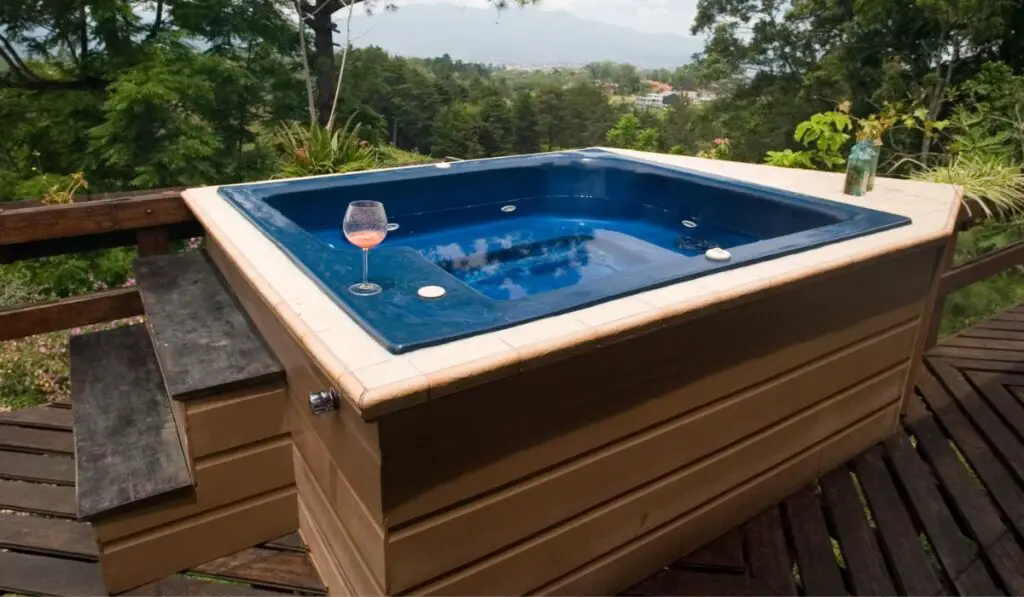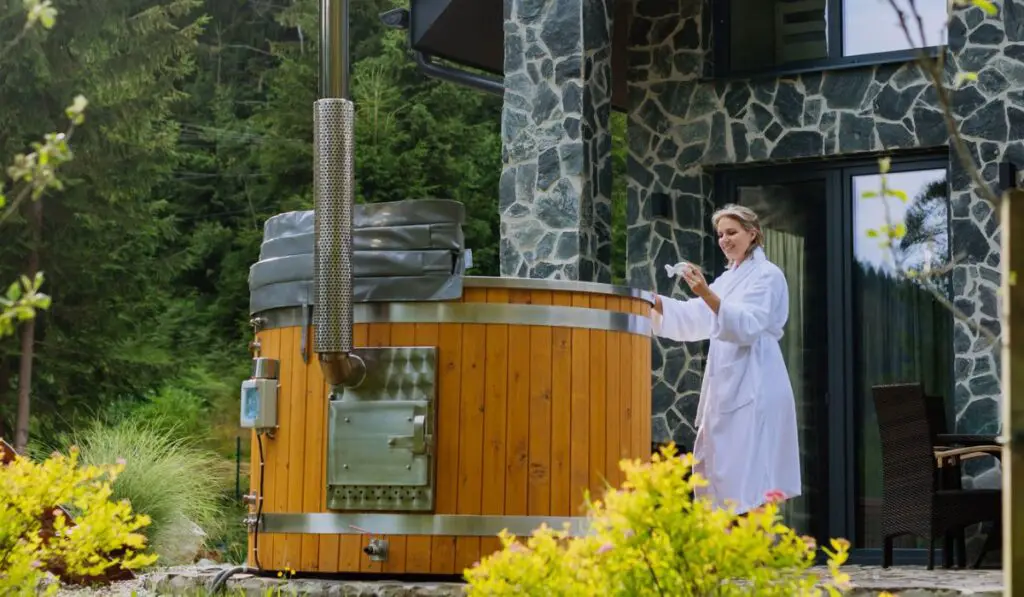Buying a hot tub can be a pretty significant investment, and it may not be the right choice for everyone. The good news is that if you’re handy and have some basic DIY skills, you can build your own hot tub for a fraction of the cost of purchasing one.
All you need to build your own hot tub is a big tub, a water heater, a pump, and a few hoses. There are unlimited options for DIY tubs, but metal stock tanks are a very popular choice. Simply place the tub in a suitable place, fill it up, and hook up the water heater and the pump.
A homemade hot tub can be just as relaxing and therapeutic as a store-bought model, and it will be uniquely yours. It’s also a fun project, and you’ll be proud of your handiwork every time you step into your tub to relax. So, what are you waiting for? Let’s look at everything you need to know to build your own hot tub.
Can You Build a Hot Tub at Home?

Of course! As long as you’re willing to put in the work, you can build a hot tub right in your own backyard. Remember that this isn’t a small project; you’ll need a large enough space, the necessary tools and materials, and some basic carpentry skills.
But if you’re up for the challenge, building your own hot tub can be fun and rewarding. Not only will you save money, but you’ll also end up with a unique and custom-made product that you can be proud of.
And before we get too far into it, be sure and consider inflatable hot tubs as an option. You may be doing a DIY hot tub because you simply want it custom, but if your primary motivation is price, know that some inflatable models like the Intex PureSpa Plus (on Amazon) can get you most of the effect for less than a grand.
OK, now back to making your own!
What to Consider Before Building
There are four main things you need to consider before starting your hot tub build:
1. The Location of the Tub
Hot tubs are heavy, which means you can’t place them just anywhere in your yard. You’ll need to find a level spot that can support the weight of the tub and its occupants.
So, before you even start visualizing your future hot tub in your backyard oasis, make sure you have a solid foundation that can accommodate the weight. If you don’t have a suitable surface, you’ll need to build a wooden or concrete pad to support it.
Apart from finding a strong spot, you’ll also want to consider access to the electric and water lines. Can you easily hook up the tub to these utilities? If not, you’ll need to factor in the cost of running lines to the tub.
2. The Size and Material of the Tub
Now that you’ve found the perfect spot for your tub, it’s time to start thinking about the size and shape. Consider how many people you want to be able to fit in the tub and what kind of activities you want to do in it. Also, consider the water refill and maintenance cost when selecting the size — a smaller tub will be easier to manage.
Once you have a good idea of the dimensions, you can start looking at different materials. The most common material for DIY hot tubs is wood, metal, and concrete.
Consider your skill set when making your decision. If you’re handy with woodworking, you may want to opt for a wooden tub. But if you’re looking for something that comes ready to go, a metal tub would be cheap and easiest to find. Concrete tubs are the most durable but also the most difficult to build.
3. The Heat Source
There are a few options to heat the water: an electric heater, propane heater, or a wood-burning stove.
Electric heaters are the most popular because they’re easier to install and use. Propane ones are better for an off-grid setup, but they can be expensive to operate in the long term.
Wood-burning stoves are the least common but can add a nice rustic touch to your tub. If you go this route, be prepared to put in some extra work — you’ll need to arrange for wood supply and build a fire every time you want to use the tub.
4. Your Budget
Each of the above choices comes with a different price tag. So your budget will be a key factor in deciding which features and materials are right for you. For example, a concrete tub will be more expensive than a wooden one but will also last longer.
An electric heater will be more expensive than a wood-burning stove, but it’s also much easier to use. Your focus should be on finding the right balance of features and cost that fits your needs and budget. Be prepared to do some research and put in some elbow grease to find the perfect combination.
Keep these considerations in mind as you start planning your project. With a little bit of research and planning, you’ll be on your way to building the perfect hot tub for your home.
What Supplies Do You Need to Build a Hot Tub?
While the exact supplies you’ll need will vary depending on the design and materials you choose, there are a few basics that every hot tub build will require:
- Tub (Either build your own or buy a pre-made one)
- Sand/Thick blanket (For leveling the tub)
- Heater (Electric, propane, or wood-burning)
- Pump (To circulate the water)
- Hoses/Pipes (To hook up the tub to the utilities)
- Filter (Optional)
- Insulation (Optional)
Expect a few more materials to be added to the list as you finalize your design and choose your materials. But with these basics, you should have everything you need to start.
What’s the Cost of Building a Hot Tub at Home?

The cost of building a hot tub will vary depending on the materials and design you choose. A basic, metal stock tank hot tub with a propane water heater and a small pump will cost around $500-$700.
The cost will increase if you want to get more creative with your design and use higher-quality materials. For example, a custom concrete tub with an electric heater and filtration system could cost $2,000 or more. So, it really depends on how much you want to spend and how elaborate you want your hot tub to be.
How Long Is the Process of Building a Hot Tub?
A simple stock tank hot tub can be set up in a matter of hours if you’ve got the necessary supplies on hand. But other options, like concrete, take days or weeks to cure and be ready for use.
Wooden tubs need sealing and waterproofing, which can add a few days to the process. So, the shortest timeline would be a few hours, and the longest could be a few weeks.
How to Build a Hot Tub
Now that you know what to consider and what supplies you’ll need, it’s time to start building your hot tub. Since there are so many different ways to build a hot tub, it can be overwhelming to figure out all the options.
To make things easier, we’ve put together this step-by-step guide to building a simple metal stock tank hot tub. This option is one of the most popular because it’s relatively easy to set up and doesn’t require any special skills or knowledge. Plus, it’s a more affordable option, which is always a bonus.
Step 1: Make a Pad
Hot tubs are heavy, so the surface underneath can sink or crack if it’s not properly supported. To avoid this, start by making a level pad for the tub to sit on. This can be done with concrete pavers, decking boards, or even a layer of sand.
If you’re putting the tub over your deck or another existing structure, use an old thick blanket or something similar to create a buffer between the two. You can cut the blanket around the tub’s edges to get a perfect fit.
Step 2: Place the Tub on the Pad
Once you’ve got your pad ready, place the tub on top. Stock tanks are made with thin sheets of metal that can get dented or damaged easily. So, ensure it’s nice and level, and there is nothing sharp that could puncture the bottom of the tub. If you hae insulation material, now would be the time to put it around the tub.
Step 3: Fill the Tub
Fill the tub with water using a hose or buckets. This method uses a pump, so the water from the tub will be recirculated through the heater and back into the tub.
Step 4: Add the Heater
Set up your heater according to the manufacturer’s instructions. Make sure it’s at a safe place, on a level surface, where it can’t fall in and cause problems. Use a backer board or something similar to protect the deck or other surface if necessary.
Step 5: Connect the Hoses
Now it’s time to connect the hoses from the tub to the heater. You’ll need three hoses in total. The first one goes from the tub to the inlet on the water pump. The second hose goes from the outlet on the pump to the inlet on the heater. The third hose goes from the outlet on the heater back to the tub.
If you want, add a shower head to the end of the third hose; it’ll make things more convenient when you’re ready to take a dip.
If you want to add a water filter, connect it to the first hose between the tub and the pump. That way, gunk is filtered out before it goes into the pump and heater.
Step 6: Turn on the Pump and Heater
Turn on the circulating pump and let it run for a few minutes to inspect if everything works properly. Look for leaks at all the connections and make sure there is no water coming out of the tub.
Now, turn on the heater and adjust the temperature to your liking. Give it some time to heat the water, and you’ll be ready to go. All that’s left to do is sit back, relax, and enjoy!
